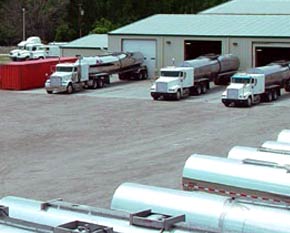Liquid Trucking Things To Know Before You Get This

Prior to packing, discharging, or driving a vessel, inspect the lorry. This ensures that the automobile is safe to carry the liquid or gas as well as is risk-free to drive. A CLP holder with a tank recommendation (N) is prohibited from running a tank vehicle unless it is empty - fuel transport. Furthermore, if the tanker previously had harmful materials, it should be removed (FMCSR § 383.25).


Tank automobiles can be found in many types and also dimensions. You need to examine the car's driver manual to see to it you know exactly how to check your container vehicle. On all storage tank vehicles, the most crucial thing to check for is leaks. Examine under and around the lorry for signs of any leaking.
To do so is a criminal offense. You will be mentioned and prevented from driving additionally. You might also be responsible for the clean-up of any type of spill. As a whole, check the following: Check the tank's body or shell for damages or leaks. Check the consumption, discharge, and cut-off valves. Make sure the valves remain in the appropriate position prior to filling, unloading, or relocating the lorry.

Examine manhole covers as well as vents. Make sure the covers have gaskets and they close correctly. Keep the vents clear so they work properly. If your car has any of the adhering to equipment, make certain it works: Vapor healing kits. Grounding and bonding cables. Emergency situation shutoff systems. Constructed in fire extinguisher.
Inspect the emergency tools required for your car. Discover what tools you are called for to bring as well as make sure you have it (and also it works). Carrying fluids in containers requires unique abilities due to the high facility of gravity and fluid activity. See Figure 8.1. Number 8.1 High center of gravity suggests that much of the load's weight is carried high up off the road.
Liquid Transport Fundamentals Explained
Fluid vessels are especially simple to roll over (liquid trucking). Tests have actually shown that tankers can pass on at the rate restricts published for curves. Take freeway contours and also on ramp/off ramp contours well listed below the published rates. Liquid surge arises from movement of the fluid in partly filled up containers. This activity can have bad impacts on handling.
When the wave hits completion of the container, it tends to press the truck in the instructions the wave is relocating. If the truck is on an unsafe surface, such as ice, the wave can push a quit vehicle out into a junction. The motorist of a liquid tanker have to be very accustomed to managing the lorry.
When loading and discharging smaller storage tanks, the motorist must focus on weight circulation. Do not place way too much weight on the front or rear of the automobile. Puzzled liquid storage tanks have bulkheads in them with holes that allow the liquid circulation via. The frustrates aid to control the forward as well as backward fluid rise.

Unbaffled fluid tankers (sometimes called "smooth bore" tanks) have nothing inside to decrease the flow of the fluid. For that reason, forward-and-back rise is really strong. Unbaffled containers are normally those that move food (milk, for instance). (Cleanliness policies restricted using baffles as a result of the problem in cleaning up the within the storage tank.) Be exceptionally mindful (slow-moving and careful) in driving smooth bore storage tanks, specifically when starting and stopping.
Liquids increase as they warm up and also you should leave space for the broadening fluid. This is called "blackout." Given that various liquids broaden by different amounts, they need various quantities of interruption. You should know the outage demand when transporting liquids wholesale. A complete container of dense fluid (such as some acids) may exceed legal weight limits.
Get This Report on Top Trucking Companies
The quantity of fluid to load right into a tank relies on: The quantity the liquid will increase en route. The weight of the liquid. Legal weight restrictions. The temperature of the load. If you are driving a storage tank car transporting more than 500 gallons of combustible fluid at a rate faster than the appropriate rate limit or in disregard for the safety and security of persons or home, along with any other applicable fine, for a very first offense you are subject to a fine of not much less than $500 and also for a 2nd or subsequent crime within 2 years of a previous infraction, you go through a fine of not much less than $2,000 as well as a suspension of as much as 6 months of an unsafe products or freight storage tank recommendation, or both (CVC § 22406.5).
In order to drive tank lorries securely, you have to bear in mind to adhere to all the secure driving regulations. A few of these guidelines are: Due to the high center of gravity as well as the surge of the liquid, you have to begin, slow down, and stop really efficiently. Additionally, make smooth turns and lane changes.
Do not release the brakes prematurely when coming to a stop. Brake far in development of a quit and increase your adhering to distance. If you must make a quick quit to stay clear of an accident, usage regulated or stab braking. If you do not bear in mind how to quit utilizing these techniques, evaluation Section 2 .
Slow down before curves, and after that accelerate a little through the curve. The published speed for a curve may be too quick for a container vehicle. Remember just how much space you need to stop your vehicle. Keep in mind that wet roadways double the typical quiting range. Vacant tank vehicles may take longer to stop than full ones.
trucking companies hiring local driverstruck driving jobs out westtransport companies hiring
If you do, your lorry might skid - fuel transport. On container trailers, if your drive or trailer wheels begin to skid, your lorry might jackknife. When any type of lorry begins to skid, you should act to restore traction to the wheels. Examination Your Expertise Just how are bulkheads different than baffles? Should a tank lorry take curves, on ramps, or off ramps at the posted rate restrictions? How are smooth bore tankers different to drive than those with baffles? What 3 points identify just how much fluid you can load? What is blackout? How can you aid manage surge? What 2 factors make special care necessary when driving container cars? These concerns might get on the test.